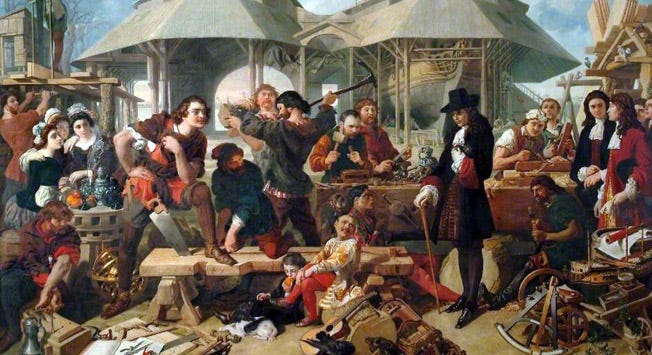PETER THE GREAT SHIPBUILDER
Alcatraz, Bering, Enid Blyton & Rabelaisian
BOC#032
7 MINUTE MUNCH
TITLE PIECE: SHIPS, BEARDS, AND RUSSIAN PROGRESS…
Peter the Great who ruled Russia 1682 - 1725 is remembered for his policy of modernisation and transformation; a self-imposed mission to align Russia with the best of Europe. In BOC#023 we mentioned that he imposed a tax on beards, a policy designed to capture the very essence of his transformational vision for a more culturally up-to-date Russia. But it was his incognito tour of Europe and technical apprenticeships at the shipyards of the mighty European wharfs that seemed to transcend his autocratic leadership style.
Fuelled by a desire for empire, his obsession with ships would take him on a journey of maritime education and expansion rivalling some of the best maritime projects of his day.
In 1687 at the age of 15, Peter, who was fascinated by the military traditions of western Europe, met a young Dutch merchant by the name of Franz Timmerman. While out walking one day, the pair came across a storehouse that had been locked for twenty years. Peter asked to look inside, only to discover the decaying remains of what Timmerman identified as “an English boat”. It was like no boat Peter had ever seen before. His fascination with shipbuilding was thus born.
Peter went on to spend much of 1687 building a boatyard on the shores of Lake Pleschev, and much later in 1696, he would go on to employ the English and Dutch shipwrights who would help him fulfil his vision for a great fleet to be built along the River Voronezh. While these ships were never used for their intended purpose of winning the city of Kirch which had been under Ottoman control, Peter’s Foreign Minister Emilian Ukraintsev, would one day be sent to Constantinople in a brand new forty-six-gun frigate named The Fortress, escorted by twelve other Russian ships in a persuasive show of force. His Grand Tour of Europe had much to thank for this great maritime achievement.
The so called ‘Grand Embassy’ of 1697 exposed Peter to the true extent to which Russia was lagging behind the likes of Germany, England, and the Netherlands, all of whom considered Russia to be somewhat of a cultural backwater with medieval political institutions and an outdated social belief system. Peter would thus go on to drive a much needed cultural revolution in the beloved nation he called home.
From obsolete gowns to antiquated beards, Peter sought to bring Russia into the enlightened orbit of European success. So zealous was Peter’s endeavour that in addition to the ban on beards, he banned the wearing of traditional curved knives at the waist, and ordered guards to cut the old-style robes off anyone entering the city. By 1700, men were required to wear the waistcoat and breeches of their European counterparts; women were to wear bonnets, dresses, and petticoats. It was time to bring an end to the symbolism of antiquity.
The beard had long been associated with the religious orthodoxy of the church who declared the cutting of the beard a mortal sin. Shaving, which had once been a crime under Ivan the Terrible, was now a duty.
Peter’s Great Embassy of 1697 made him the first Russian Tsar to have travelled so far afield in peacetime. To his mother’s dismay, he was also the first Tsar to have embarked on the 1000 mile saltwater voyage to Russia’s only port at Archangel.
His journey to western Europe took him overland through the Swedish controlled territories of Finland, Estonia and Latvia, paying particular attention to the strategic maritime city of Riga. This fortified city was of particular interest to Peter’s father’s who’d failed to seize it forty years earlier. Peter took it upon himself to sketch and measure the very fortifications that had been built to ward off Russian meddling. According to one story, a Swedish soldier had threatened to shoot the ‘unknown foreigner’ who was so audacious as to take such brazen measurements and observations. Peter found this all rather rude, and three years later, referenced the experience as an excuse to attack the city in the opening gambit of the Great Northern War.
Peter was otherwise received well in Europe. His humor and charm made him popular amongst the German laity. His experience of western Europe was one of technological progress and unrelenting modernity. From clocks and chronometers to compasses and barometers, the fields of cartography and navigation were as impressive as the commodity markets that saw tea, sugar and spices arrive in droves thanks to the maritime exploits of the British and Dutch East India and West India Companies.
The Dutch Golden Age was well under way, seeing the Netherlands rank as one of the most advanced nations in 17th century Europe. The Dutch were spearheading developments in the arts and sciences, from painting, sculpture, architecture, and drama, philosophy, law, mathematics, and publishing.
Peter found work at a Dutch shipyard belonging to the Dutch East India Company, spending four months working and touring the Dutch Republic. It was during this time that he learnt the art of shipbuilding, ship anatomy, repair and naval architecture. Along with a selection ten Russian companions, he participated in the construction of 100 ft frigate that the Company called ‘The Apostles Peter and Paul’ in his honour. When he wasn’t working on ships, he studied under leading Dutch experts in the fields of architecture, drawing and engraving, engineering, book printing, anatomy, medicine, and surgery. He studied microscopes, barometers, wind dials, coins, cadaver and dental pliers, as well as artillery.
Upon his return, Peter set about enforcing a series of changes to Russian society. He was now convinced that ‘the roots of Western technological achievement lay in the freeing of men’s minds.’
Tobacco, which had once carried the death penalty, was legalised, the Orthodox Church had its powers clipped, the army was expanded, coinage was standardised, and the start of the year was moved from September 1st to January 1st to name but a few revolutionary changes.
In 1703 Peter founded the great city of St. Petersburg which would become the new capital of the Russian empire; home to the shipyards of Lake Ladoga. The city, which began as a fortress at the mouth of the Neva was the Russian answer to Amsterdam, London and Venice. It wasn’t the attractive destination of today, however, leaving Peter to employ his autocratic powers, forcing Muscovites to populate the new city.
In the early 1720s, Peter had dreamed up a ‘Great Northern Expedition’ that would see the Danish mariner Vitus Bering lead a party of some three thousand men and resources across Siberia to Okhotsk where they were to build ships and set sail for Japan and the Kuril Islands. They were then to build two more ships, sail to Kamchatka, form an outpost, and sail east across the Pacific where they would explore the west coast of America. The mission was certainly as ambitious as it sounds, and the crews encountered several challenges, but that’ll be the topic of another post. The expedition was yet another display maritime power that promised to put Russia on the map.
Unfortunately, Peter died before the Great Expedition could fully manifest, but his wife Catherine, having become the new Empress, continued to support her husband’s dream.
Peter had been suffering from bladder problems for a few years, and eventually came down with a high fever in January 1725. An infection had so far developed that Gangrene was found in his bladder. There was nothing that could be done, and after three weeks of suffering, Peter lost consciousness and died. As he drifted off, he murmured “I hope God will forgive me my many sins because of the good I have tried to do for my people.”
His legacy is best captured by his appendage, ‘the great’. With a passion for ships just as vigorous as his vision for a progressive Russia, Peter undertook a voyage of progress and development that made Russia the respectable nation he’d long dreamt it to be.
DID YOU KNOW…
The Bering land bridge which once connected Russia to Alaska was no mere bridge. Named after Vitus Bering, and existing during the last ice age (11,000 -36,000 years ago), it covered the approximate distance from Paris to Copenhagen. It was four times wider than most of Central America from ocean to ocean, and if a man stood in the middle, he would think of himself on a substantial part of a continent. The land bridge is thought to have been the primary route of human migration from Asia to the Americas during the last ice age.
ON THIS DAY: 11th AUGUST
The first batch of 137 prisoners arrived at Alcatraz prison today in 1934. In June 1962, Frank Morris, John Anglin, and Clarence Anglin would cause embarrassment by escaping the high security prison. They were never to be found. The FBI closed the case in 1979, although the prison was shut down in 1963.
The London gangsters Ronnie and Reggie Kray, who were sentenced to life in 1969, were escorted to attend their mother’s funeral today in 1982.
Airbnb was officially launched today in 2008.
Comedian and actor Robin Williams died today in 2014 aged 63, he had committed suicide.
“I never put off till tomorrow what I can possibly do - the day after.”
― Oscar Wilde
RABELAISIAN:
From Francois Rabelais, the French satirist who created the sixteenth century fictional giant Gargantua from whence we get the word gargantuan. Francois’ works are bawdy, earthy, full of farting, overeating, and gross robust humor which defines the adjective derived from his name; Rabelaisian.
FROM THE AUTHORS MOUTH:
The English children’s writer Enid Mary Blyton, author of The Famous Five, The Secret Seven and Noddy, was born today in 1897 in London.
Enid was once a teacher, and published her first book of poems in 1922. She went on to publish a staggering 30 books a year, with her titles having been translated into some 90 languages. She died in 1968.
MISSED LAST WEEK? Read Here: The Man Who Stole India
[Links marked with * are affiliate links]












Interesting read! Thank you!
I love history, and have been exploring Russian history as Russia is once again a rising power full of religious and cultural significance.
European history, when browsing libraries, is mostly England and France, which was also what I learned way back in school. Historical movies also concentrate on the same countries.
In my senior years, it's wonderful to have the long and interesting history of another part of European history to learn about.
Thanks!